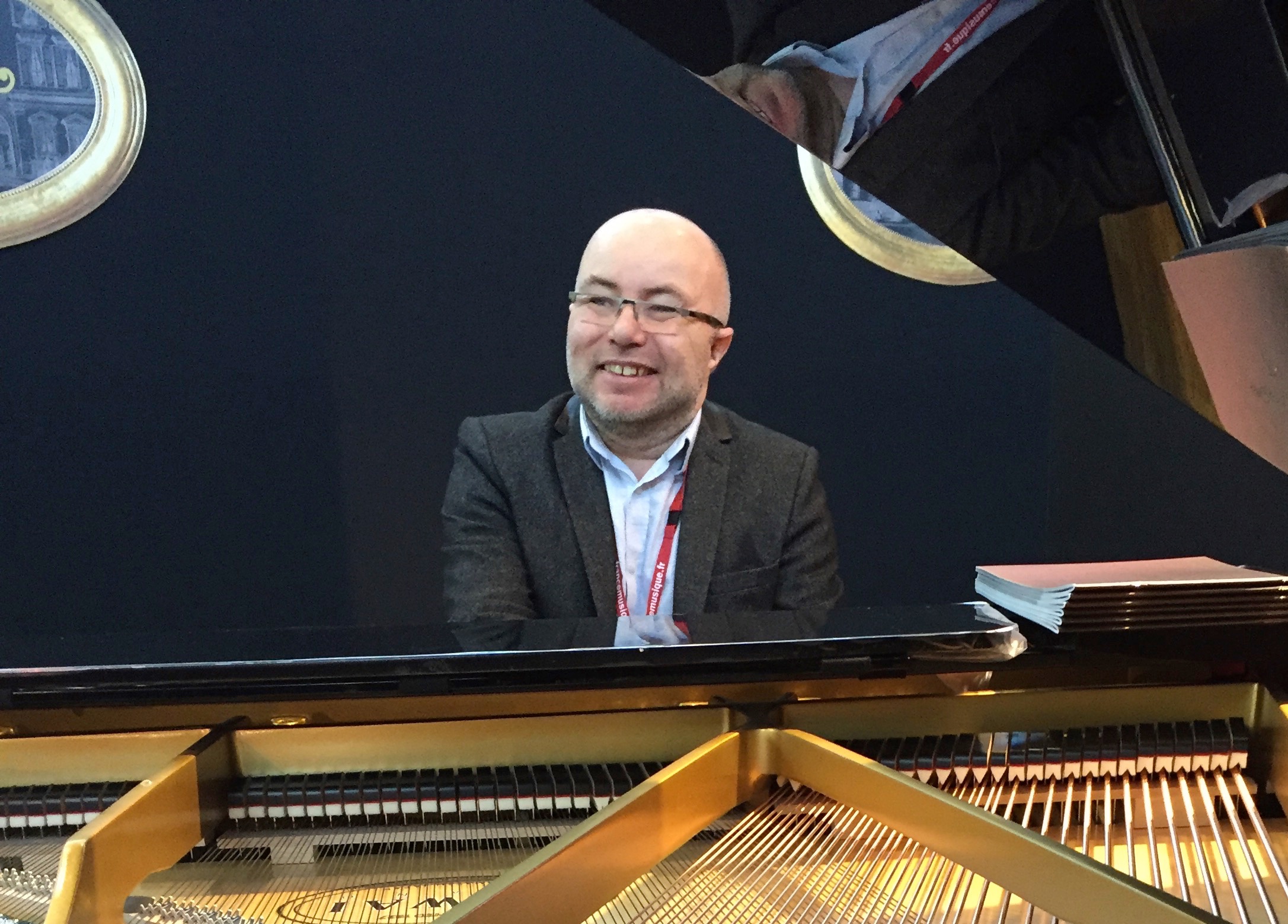-
Posts
1,066 -
Joined
-
Last visited
Reputation Activity
-

-

-

-
 Stephane Boussuge got a reaction from JulioHerrlein in Automatically split chord for piano notation
Stephane Boussuge got a reaction from JulioHerrlein in Automatically split chord for piano notation
Hi Achim,
many possible ways but I did a function for my own usage for piano split.
Here's the function with doc in French ! 🙂
All the best !
Stéphane
split-point.lisp split-point.rtfd.zip
-
 Stephane Boussuge reacted to opmo in Session 9 - 11.07.20
Stephane Boussuge reacted to opmo in Session 9 - 11.07.20
Please make documentation for it, then we can add the chord list into the system and not Libraries.
-
 Stephane Boussuge reacted to JulioHerrlein in Session 9 - 11.07.20
Stephane Boussuge reacted to JulioHerrlein in Session 9 - 11.07.20
Dear Janusz,
I think that this could be a good thing to really implement in Opusmodus. I´m finetuning it, because it involves not only a programming point of view, but also a theoretical and compositional way of thinking music. I feel that it deserves a better explanation, because a lot of chord symbols are based on my experience and also based in my Combinatorial Harmony Book.
After the finetuning, I´m going to make an video explanation of it, to make the things clearer.
If you are interested we can build something to include in the current library of Opusmodus.
All the best !
Julio
-
 Stephane Boussuge reacted to opmo in Session 9 - 11.07.20
Stephane Boussuge reacted to opmo in Session 9 - 11.07.20
5, 7 min is not acceptable 🙂
Please send me the entier file with all the chords (compressed by email) and I will have a look.
-
 Stephane Boussuge got a reaction from Nikos in Session 9 - 11.07.20
Stephane Boussuge got a reaction from Nikos in Session 9 - 11.07.20
Here's the material score and output of this session.
Happy studies !
S.
NonLinear Reflection.mp3 NonLinear Reflection - Partition complète.pdf DanielFuncDef.opmo RenéWohNonLinear.opmo
-

-
 Stephane Boussuge reacted to opmo in ps with display-midi
Stephane Boussuge reacted to opmo in ps with display-midi
I will add this option to the next release.
-
 Stephane Boussuge reacted to Rene in Session 8 - 04.07.20
Stephane Boussuge reacted to Rene in Session 8 - 04.07.20
Thank you very much, dear Stéphane, that was very interesting.
-
 Stephane Boussuge reacted to opmo in Opusmodus 2.1.25892
Stephane Boussuge reacted to opmo in Opusmodus 2.1.25892
2.1.25892
– Fixed:
Stop playback with <Cmd>-<Escape>, will no longer append MIDI entry input as if you were in a chord or the sustain pedal was down.
– Changes:
Revised attributes list entry.
Pitch-Bend Down-Half is now assign to attributes.
Pitch-Bend Up-Half is now assign to velocities.
– Documentation
Revised MIDI Entry document.
Best wishes,
Janusz
-

-
 Stephane Boussuge got a reaction from hujairi in Session 7 - 27.06.20
Stephane Boussuge got a reaction from hujairi in Session 7 - 27.06.20
Hi everybody,
Here are the files from session 7.
Happy Opusmodusing !
Stéphane
Counterpoint27062020.opmo Unfold1-27062020.opmo Rules1-27062020.opmo
-
 Stephane Boussuge reacted to torstenanders in Opmo 1.3: Emacs interface (with SLIME) broken?
Stephane Boussuge reacted to torstenanders in Opmo 1.3: Emacs interface (with SLIME) broken?
If your goal is for you as a teacher to create documents for your students to read containing Common Lisp and Opusmodus code, and where you want to evaluate the code directly from within that document, then Org mode with embedded Common Lisp + Slime is your friend. This is a very powerful combination, that can automatically create nice slides (with the LaTeX beamer interface), embed music notation (Lilypond) etc. I used this combination for years for teaching, had then all sessions of a course in a single document for easily moving content around etc.
Nevertheless, you likely do not want to introduce your students to use Org mode... For that, Jupyter notebooks (or plain Opusmodus) will be more easy for the students.
Org mode for Emacs – Your Life in Plain Text
ORGMODE.ORG Org: an Emacs Mode for Notes, Planning, and Authoring
Babel: active code in Org-mode
ORGMODE.ORG
However, I don't know of a way to automatically embed music notation output of Opusmodus in Emacs Org mode. What is missing for that, AFAIK, is some Opusmodus function that automatically creates a graphic file for a given snippet or score. If that would be there, that feature shouldn't be too hard to add (other Org mode babel programming language interfaces do already similar things, e.g., Lilypond, and the code for that is freely available).
-
 Stephane Boussuge got a reaction from opmo in Session 7 - 27.06.20
Stephane Boussuge got a reaction from opmo in Session 7 - 27.06.20
Hi everybody,
Here are the files from session 7.
Happy Opusmodusing !
Stéphane
Counterpoint27062020.opmo Unfold1-27062020.opmo Rules1-27062020.opmo
-
 Stephane Boussuge got a reaction from JulioHerrlein in Session 7 - 27.06.20
Stephane Boussuge got a reaction from JulioHerrlein in Session 7 - 27.06.20
Hi everybody,
Here are the files from session 7.
Happy Opusmodusing !
Stéphane
Counterpoint27062020.opmo Unfold1-27062020.opmo Rules1-27062020.opmo
-
 Stephane Boussuge reacted to opmo in Opusmodus version 2.1, end of June!
Stephane Boussuge reacted to opmo in Opusmodus version 2.1, end of June!
MIDI ENTRY
To start the MIDI input into your score file, select the command MIDI Entry from the Tools menu. When MIDI Entry is ON, the Listener echo bar will change to orange:
Now you know the MIDI Entry is ON. Depending on the position of the pitch-bend wheel and the modulation wheel as well as the position of the sustain pedal the colour of the Listener echo bar will change.
To make the MIDI Entry as functional as possible there are a number of commands that will increase the speed of your work without the need to move away form your MIDI keyboard.
Every entry is octave independent, except the pitch entry.
Pitch
Enter pitch symbols and chords into your score.
Length and Tuplet
Pitch-Bend: Up-Full
C 1 D 1/2 E 1/4 F 1/8 G 1/16 A 1/32 B 1/64 Cs 3 Ds 5 Fs 6 Gs 7 Bb 9
Length-rest and Tuplet
Pitch-Bend: Down-Full
C -1 D -1/2 E -1/4 F -1/8 G -1/16 A -1/32 B -1/64 Cs -3 Ds -5 Fs -6 Gs -7 Bb -9
Velocity
Pitch-Bend: UP-Half
C pppp Cs ppp D pp Eb p E mp F mf Fs f G ff Gs fff A ffff Bb < B >
Attribute
Pitch-Bend: Down-Half
C stacc Cs ord D marc Eb fermata E mart F ten Fs pizz G leg Gs trem A tie Bb ped1 B ped
Microtonality and Commands
Modulation Wheel: Up
Add a microtonal symbol next to the pitch symbol.
F + G - A . B .. C parenthesis pair D open parenthesis E close parenthesis Cs move forward char Eb move backward char Fs delete backward char Gs undo Bb new line and indent Note: If you enable MIDI input with the modulation wheel up, you need to move it down and up again in order for it to be considered up.
Entries with Sustain Pedal Down
Pitch
Add a pitch symbol next to the previous pitch (chord).
Length and Tuplet
Pitch-Bend: Up-Full
Add a length entry to the previous length value (combine length).
Length-rest and Tuplet
Pitch-Bend: Down-Full
Add a length-rest entry to the previous rest value (combine length).
Velocity
Pitch-Bend: Up-Half
Add < or > dynamic symbol to the previous velocity value.
Attribute
Pitch-Bend: Down-Half
Add (+) attribute to the previous attribute value (combine attributes).
Examples:
c4e4g4 Enter a chord c4e4g4 on your MIDI keyboard or pitch by pitch: c4 e4 g4 with sustain pedal down. (q c4 mp e4 g4) 1. Modulation wheel up then C => () 2. PB-UpF then E => (q) 3. Enter c4 => (q c4) 4. PB-UpH then E => (q c4 mp) 5. Enter e4 then g4 => (q c4 mp e4 g4) (q c4 mp e4 stacc g4 p fermata+trem) 1. Modulation wheel up then C => () 2. PB-UpF then E => (q) 3. Enter c4 => (q c4) 4. PB-UpH then E => (q c4 mp) 5. Enter e4 => (q c4 mp e4) 6. PB-DnH then C => (q c4 mp e4 stacc) 7. Enter g4 => (q c4 mp e4 stacc g4) 8. PB-UpH then Eb => (q c4 mp e4 stacc g4 p) 9. PB-DnH then Eb => (q c4 mp e4 stacc g4 p fermata) 10. PB-DnH then Gs + sustain => (q c4 mp e4 stacc g4 p fermata+trem) (q c4 mp e4 stacc g4 p fermata+trem 3q c4 eb4 fs4) 1. Modulation wheel up then C => () 2. PB-UpF then E => (q) 3. Enter c4 => (q c4) 4. PB-UpH then E => (q c4 mp) 5. Enter e4 => (q c4 mp e4) 6. PB-DnH then C => (q c4 mp e4 stacc) 7. Enter g4 => (q c4 mp e4 stacc g4) 8. PB-UpH then Eb => (q c4 mp e4 stacc g4 p) 9. PB-DnH then Eb => (q c4 mp e4 stacc g4 p fermata) 10. PB-DnH then Gs + sustain => (q c4 mp e4 stacc g4 p fermata+trem) 11. PB-UpF Cs/E (chord) => (q c4 mp e4 stacc g4 p fermata+trem 3q) 12. Enter c4 then eb4 then fs4 => (q c4 mp e4 stacc g4 p fermata+trem 3q c4 eb4 fs4) Best wishes,
Janusz
-
 Stephane Boussuge got a reaction from hujairi in Session 6 - 20.06.20 - From Nothing (Part 2)
Stephane Boussuge got a reaction from hujairi in Session 6 - 20.06.20 - From Nothing (Part 2)
Hi folks,
here's the file from the last session.
Happy study !
Stéphane
FromNothingSuite-20-06-2020.opmo
-
 Stephane Boussuge reacted to opmo in Opusmodus and Emacs-Slime Setup
Stephane Boussuge reacted to opmo in Opusmodus and Emacs-Slime Setup
Build-in Slime in Opusmodus coming soon.
Here is the 'Emacs-Slime Setup.lisp' extension file:
;;;--------------------------------------------------------- ;;; SLIME in Opusmodus ;;;--------------------------------------------------------- #! ;;; HOWTO If you're accustomed to Emacs and Common Lisp, you may prefer SLIME, the Superior Lisp Interaction Mode for Emacs, to editing lisp in regular Opusmodus windows and its listener. There are a number of places to get Emacs for MacOS. One that works well is: https://emacsforosx.com SLIME ships with Opusmodus, in the "/Applications/Opusmodus.app/Contents/Resources/third-party/slime" directory. There are two parts to Slime: 1. Swank, the server, a Common Lisp system, which runs inside of the Opusmodus App. 2. Slime, the client, which is an Emacs lisp package. To start the Swank server when Opusmodus starts, comment out the (start-swank) form at the end of this file, and restart Opusmodus (or execute (start-swank) in the Listener to do it now, but not next time Opusmodus starts). To load Slime into your Emacs, define the following in your ~/.emacs startup file: (load "/Applications/Opusmodus.app/Contents/Resources/third-party/slime/emacs-opusmodus.el") (load-opusmodus-slime) If you want to use the Mac Command key for Emacs meta, instead of the default of the Mac Option key, and make C-o in dired open the file at point, in the Mac application that is assigned for editing that type of file, also add, after that: (opusmodus-options) Then, restart Emacs, and do 'm-x slime-connect'. For Host, use the default of localhost. For Port, use 4005, or the port you specified in the (start-swank) call. 4005 will likely be the default. With (ignore-errors (slime-connect "localhost" 4005)) in your ~/.emacs startup file, the slime will start automatically at Emacs start. A "*slime-repl ccl*" buffer should appear. You can get to that buffer at any time with 'c-c s r' in Emacs. It is a read-eval-print loop, executing inside the Opusmodus App. Use it just as you do the Opusmodus Listener. There are some Opusmodus commands that may be executed from Emacs. They are all on the "om-selector", accessible via "C-c o". That will bring up a query for a single character ("Select [?alqsv]"). You may type one of: ?: Show this help buffer. a: Audition and Notation (snippet). l: Audition and Notation last score. q: Quit selector. s: Stop audition. v: Voices Audition and Notation (snippet). The "snippet" is the lisp form before the insertion point, as in Opusmodus. The commands (other than ? and q) behave as the like-named commands in the Opusmodus Tools/Snippet menu, except they open a new (reusable) notation window, instead of a new notation panel. When connected to Slime, errors in the Opusmodus Listener will bring up a backtrace dialog in the connected Emacs, NOT the CCL debugger in the Listener. Be careful to use the "Return to toplevel" restart from there, not one of the ones that kills the thread, or you'll break your Opusmodus, and will have to restart it. !# ;;; End of HOWTO ;; To start the Swank server when Opusmodus starts, you need to ;; uncomment the (start-swank) expression below: It can take a first ;; arg to change the port from the default of 4005, and a second arg ;; to change the directory from which to load Swank from the default ;; of inside the application bundle (you should only do this if you ;; need to run a different version of Swank, to be compatible with a ;; different version of Slime in your Emacs). (in-package :om) ; (start-swank) Janusz
-
 Stephane Boussuge got a reaction from JulioHerrlein in Why I Use Opusmodus
Stephane Boussuge got a reaction from JulioHerrlein in Why I Use Opusmodus
Great !!
I love the humour too !
All the best !
Stéphane
-
 Stephane Boussuge reacted to JulioHerrlein in Why I Use Opusmodus
Stephane Boussuge reacted to JulioHerrlein in Why I Use Opusmodus
WHY I USE OPUSMODUS SOFTWARE IN MY MUSICAL COMPOSITION PROCESS
In this video I will describe some of the techniques I used in my compositional process and why I decided to use OPUSMODUS Software for compose music ! Also my experience with Pure Data and Nodal Software before moving to Opusmodus.
-
 Stephane Boussuge reacted to Avner Dorman in Negative Harmony Function
Stephane Boussuge reacted to Avner Dorman in Negative Harmony Function
another p.s. - Ernst Levy's book is available on google play
A Theory of Harmony
BOOKS.GOOGLE.DE In this introduction to natural-base music theory, Ernst Levy presents the essentials of a comprehensive, consistent theory of harmony developed from tone structure. A Theory of Harmony is a highly original explanation of the harmonic language of the last few centuries, showing the way toward an understanding of diverse styles of music. Basic harmony texts exist, but none supply help to students seeking threads of logic in the...
My favorite book on the subject is David Lewin's:
Generalized Musical Intervals and Transformations. New Haven, CT, and London: Yale University Press, 1987. Reprinted, Oxford and New York: Oxford University Press, 2007.
-
 Stephane Boussuge got a reaction from TomTolleson in Session 6 - 20.06.20 - From Nothing (Part 2)
Stephane Boussuge got a reaction from TomTolleson in Session 6 - 20.06.20 - From Nothing (Part 2)
Hi folks,
here's the file from the last session.
Happy study !
Stéphane
FromNothingSuite-20-06-2020.opmo
-
 Stephane Boussuge got a reaction from opmo in Session 6 - 20.06.20 - From Nothing (Part 2)
Stephane Boussuge got a reaction from opmo in Session 6 - 20.06.20 - From Nothing (Part 2)
Hi folks,
here's the file from the last session.
Happy study !
Stéphane
FromNothingSuite-20-06-2020.opmo




